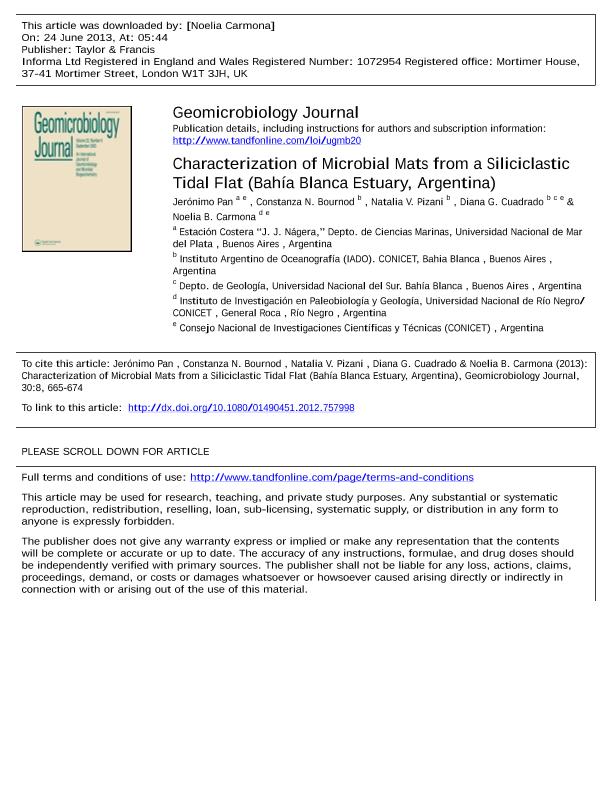Mostrar el registro sencillo del ítem
dc.contributor.author
Pan, Jeronimo

dc.contributor.author
Bournod, Constanza Naimé

dc.contributor.author
Pizani, Natalia Veronica
dc.contributor.author
Cuadrado, Diana Graciela

dc.contributor.author
Carmona, Noelia Beatriz

dc.date.available
2015-11-24T15:56:45Z
dc.date.issued
2013-06-18
dc.identifier.citation
Pan, Jeronimo; Bournod, Constanza Naimé; Pizani, Natalia Veronica; Cuadrado, Diana Graciela; Carmona, Noelia Beatriz; Characterization of Microbial Mats from a Siliciclastic Tidal Flat (Bahía Blanca Estuary, Argentina); Taylor Francis; Geomicrobiology Journal; 30; 8; 18-6-2013; 665-674
dc.identifier.issn
0149-0451
dc.identifier.uri
http://hdl.handle.net/11336/2897
dc.description.abstract
Biofilms and microbial mats cover the tidal flats of the central zone of the Bah´ıa Blanca estuary (Argentina), creating extensive layers. The objective of this study was to characterize the microphytobenthic communities in these biofilms and mats from sediment cores taken in March, June, September and December 2010. Microorganisms were identified and enumerated by microscopy, and their biomass (chlorophyll a, biovolume) quantified at two different stations in the lower supratidal zone, located ∼210 m apart from each other (namely S1 and S2). Additionally, the colloidal carbohydrates produced by these microbial communities were quantified, together with physical parameters such as temperature, granulometry, moisture and organic matter content of the sediment layers that comprise a typical epibenthic mat. On the other hand, changes in biomass and colloidal carbohydrate content were studied through a half-tidal cycle (7 h). There were significant seasonal differences in microphytobenthic biovolume (P < 0.001) with a considerably lower biomass in summer, but no significant differences in microalgal biovolume between stations (P = 0.454). Cyanobacterial biomass (largely composed of the filamentous Microcoleus chthonoplastes) was dominant on all dates at both stations, followed by pennate diatoms. Chlorophyll a and colloidal carbohydrate contents in sediment presented a similar pattern to that of microalgal biovolume; with a 5-fold variation in chlorophyll a for S1 between consecutive sampling events on September and December. There were significant differences between sampling dates in colloidal carbohydrates (P < 0.001) with the lowest values recorded during fall and winter; conversely there were no significant differences between stations (P = 0.324). Silt was the dominant sediment fraction at S1 while sand dominated throughout the uppermost 20 mm at S2. Chlorophyll a contents did not show significant differences throughout a half-tidal cycle, likely the product of vertical migration along the section sampled. Conversely, the content of colloidal carbohydrates varied 5-fold, showing a significant (P < 0.001) and steady increase with time of exposure to air and pointing to the rapid metabolic rates of the community. In conclusion, the microphytobenthic community of the Bah´ıa Blanca estuary presented marked seasonality in its biological parameters and overall physiognomy, also showing elevated metabolic rates when subject to tidal fluctuations.
dc.format
application/pdf
dc.language.iso
eng
dc.publisher
Taylor Francis
dc.rights
info:eu-repo/semantics/openAccess
dc.rights.uri
https://creativecommons.org/licenses/by-nc-sa/2.5/ar/
dc.subject
Biofilms
dc.subject
Cyanobacteria
dc.subject
Diatoms
dc.subject
Microbial Mats
dc.subject
Microphytobenthos
dc.subject
Tidal Flat
dc.subject.classification
Otras Ciencias de la Tierra y relacionadas con el Medio Ambiente

dc.subject.classification
Ciencias de la Tierra y relacionadas con el Medio Ambiente

dc.subject.classification
CIENCIAS NATURALES Y EXACTAS

dc.title
Characterization of Microbial Mats from a Siliciclastic Tidal Flat (Bahía Blanca Estuary, Argentina)
dc.type
info:eu-repo/semantics/article
dc.type
info:ar-repo/semantics/artículo
dc.type
info:eu-repo/semantics/publishedVersion
dc.date.updated
2016-03-30 10:35:44.97925-03
dc.journal.volume
30
dc.journal.number
8
dc.journal.pagination
665-674
dc.journal.pais
Estados Unidos

dc.description.fil
Fil: Pan, Jeronimo.
dc.description.fil
Fil: Bournod, Constanza Naimé. Consejo Nacional de Investigaciones Científicas y Técnicas. Centro Científico Tecnológico Mar del Plata. Instituto de Investigaciones Marinas y Costeras; Argentina
dc.description.fil
Fil: Pizani, Natalia Veronica. Consejo Nacional de Investigaciones Científicas y Técnicas. Centro Científico Tecnológico Bahia Blanca. Instituto Argentino de Oceanografia (i); Argentina
dc.description.fil
Fil: Cuadrado, Diana Graciela. Consejo Nacional de Investigaciones Científicas y Técnicas. Centro Científico Tecnológico Bahia Blanca. Instituto Argentino de Oceanografia (i); Argentina
dc.description.fil
Fil: Carmona, Noelia Beatriz. Universidad Nacional del Sur. Departamento de Geologia; Argentina. Consejo Nacional de Investigaciones Científicas y Técnicas. Centro Científico Tecnológico Bahia Blanca. Instituto Argentino de Oceanografia (i); Argentina
dc.journal.title
Geomicrobiology Journal

dc.relation.alternativeid
info:eu-repo/semantics/altIdentifier/doi/10.1080/01490451.2012.757998
dc.relation.alternativeid
info:eu-repo/semantics/altIdentifier/doi/http://dx.doi.org/10.1080/01490451.2012.757998
dc.relation.alternativeid
info:eu-repo/semantics/altIdentifier/url/http://www.tandfonline.com/doi/abs/10.1080/01490451.2012.757998
Archivos asociados
